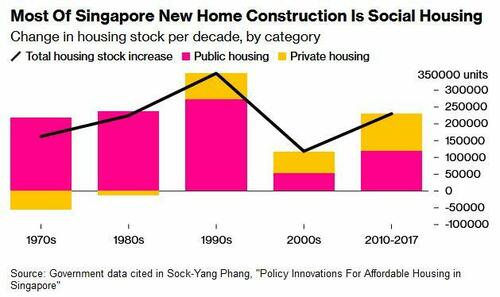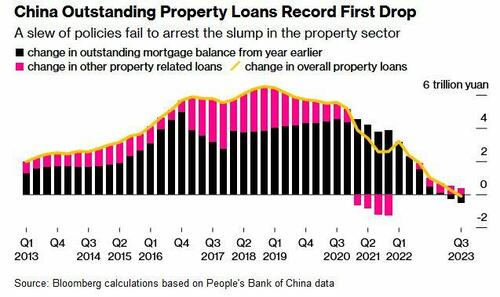
On Sunday we noted that Beijing would be employing several schemes to try and put a floor under its spiraling property crisis – chief among them, providing at least 1 trillion yuan (US$137 billion) in low-cost financing to renovate urban villages and build new, affordable housing (which, according to Bloomberg‘s Ye Xie, George Lei and Henry Ren, might not be enough). Photo: BloombergBeijing announced the two-pronged approach over the past few weeks, which have top-level political backing for financing equivalent to approximately 10% of annual new home sales in what Bloomberg described as the “Singapore” model.
Photo: BloombergBeijing announced the two-pronged approach over the past few weeks, which have top-level political backing for financing equivalent to approximately 10% of annual new home sales in what Bloomberg described as the “Singapore” model.
Singapore, while a mecca of private-sector business and financial activity, is renowned for a residential market that’s dominated by public housing. If China’s new plan works, officials might be able to both end a nearly three-year slump in property construction and meet President Xi Jinping’s aims to promote “common prosperity.”
“The plan is more of a longer-term structural adjustment in the property sector toward a Singaporean model,” said Betty Wang, senior economist at Australia & New Zealand Banking Group in Hong Kong. “I don’t think it’s just a short-term effort to boost property investment — instead, it’s about China’s 2035 common prosperity goals.”

The yet-to-be-finalized list would expand on previous rosters created by banks that only focused on some “systemically important” state-backed firms. It underscores Beijing’s growing concerns about the sector following record defaults, a swathe of unfinished apartments and a deep contraction in real estate investment that threatens to derail growth in the world’s second-largest economy.
Some Chinese builders’ dollar bonds rallied after the report. Vanke’s 3.5% note due 2029 climbed 3.9 cents on the dollar, set for the biggest jump in two weeks, according to data compiled by Bloomberg. Longfor’s 3.85% note due 2032 rose 3.2 cents, while Seazen’s 4.8% bond due 2024 climbed 2.2 cents. -Bloomberg
According to a recent statement from Beijing, China’s largest banks, brokerages and distressed asset managers were told during a Friday gathering to meet all “reasonable” funding needs from property developers, and to “treat private and state-owned developers the same” when it comes to lending. Regulators were also asked at the event to ensure that loan issuance to private builders doesn’t outpace the industry average rate, given that China’s outstanding property loans fell for the first time on an annual basis in Q3.
Nvidia Reports Blowout Earnings, But Warns Of “Significant” China Slowdown, Guidance Matches Whisper Range
‘Hawkish’ FOMC Minutes: Warn On Fading Consumer, Financial System Stability Risks
















